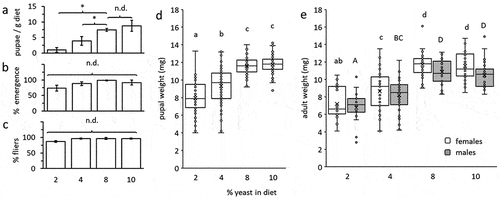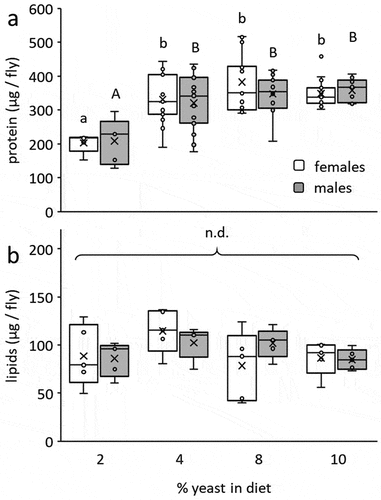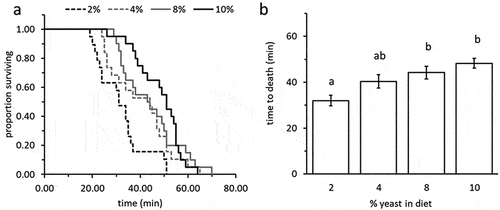Figures & data
Table 1. Larval-diet composition per 100 g of diet.
Figure 1. Larval performance was affected by the yeast content in the diet. (a) number of insects produced per weight of diet, (b) adult emergence rate, and (c) percent flying adults (Kruskal-Wallis and Wilcoxon tests, n = 3 replicates in each group, error bars depict the standard error, n.d. no differences, * significantly different). (d) box plots depicting pupal weight according to treatment (Tukey HSD comparisons, P ≤ 0.0 n = 60 individuals in each group). (e) fresh weight of 10 day old males and females participating in thermal tolerance assays, as affected by the yeast content in larval diets (ANOVA followed by Tukey HSD comparisons: P < 0.04, n = 21–35 individuals in each group). The number and weight of insects produced were significantly affected by yeast content in the diet. Different letters stand for significant differences between groups (small letterhead for females, capital letters for males).

Figure 2. Individual protein (a) and lipid (b) content in emerging B. zonata males and females as affected by the yeast content in larval diets. Protein content significantly depended on diet composition (ANOVA followed by Tukey HSD comparisons: P < 0.017) but not sex (P = 0.59, n = 5–15 individuals in each group). No significant differences in lipid reserves were detected among treatment groups (ANOVA followed by Tukey HSD comparisons: P > 0.05) or between the two sexes (P = 0.81, n = 5 individuals in each group). Different letters stand for significant differences between groups (small letterhead for females and capital letters for males).

Figure 3. Heat tolerance (time to death) of 10 days adult B. zonata exposed to 42°C as affected by the yeast content in the larval diet. (a) survival plots depicting time to death (minutes) of flies in different treatment groups. (b) Survival times (means ± SE) depending on treatment. Adults developing as larvae on a protein poor, 2% yeast diet were significantly less resistant to heat stress (generalized regression followed by Tukey HSD comparisons, t ≤ −3.71, P ≤ 0.002, n = 19–20 individuals in each group). Different letters stand for significant differences between groups.

